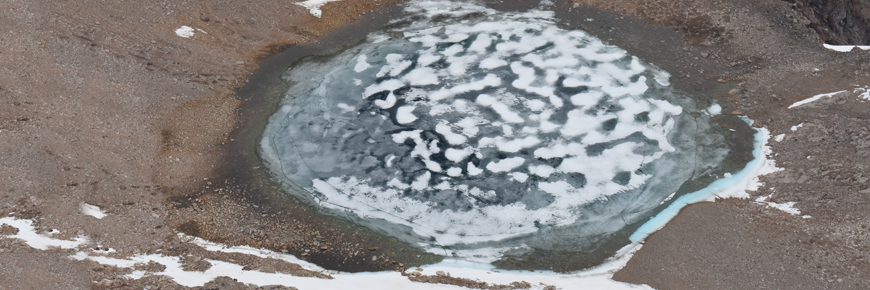
Photo: Paul Asimow
Discovery of an impact crater in Arctic Canada
Auyuittuq National Park
This project took place in summer 2018. It aimed at determining whether a circular lake within Auyuittuq National Park was an impact crater from a meteorite larger than 15 metres. Preliminary results suggest that the lake was not formed by a meteorite.
Methods
The purpose of our expedition was to determine whether or not a circular lake atop the headland between two branches of Nedlukseak Fjord is an impact crater. The research team flew to the site, made a low-altitude helicopter circuit of the lake collecting high-resolution photographs, and then landed at the lakeshore. They circled the lake on foot, observing the rocks and collecting six samples for laboratory analysis.
Discussion and preliminary results
At this time, the rock samples have been (1) sliced and polished into petrographic thin sections and (2) ground into powder and fused for whole-rock chemistry measurements. The research team is examining the thin sections for microscopic evidence of any shock features that might be present in the rocks and the whole-rock data for anomalous enrichment in elements characteristic of extraterrestrial sources. At this point both tests are negative. Indeed, the field observations are entirely consistent with the site being an ordinary lake, filling a depression formed by ordinary glacial and erosional processes. There was no field evidence of an impact. The raised rim characteristic of small bowl-shaped impact craters is absent. There were no radiating fractures visible in the bedrock outcrops, only ordinary joints whose orientation is unrelated to their position around the lake. There were no shatter cones that we could find. The team’s preliminary result is that this site is not an impact crater. Approximately circular features can arise by coincidence or by the ordinary action of glaciers and erosion. Dr. Asimow and his team will finish confirming their field observations through detailed microscopic observation of the collected samples, but at this time they do not expect to find evidence of shock in the samples.
Research team
Dr. Paul Asimow, Division of Geological and Planetary Science, California Institute of Technology
Dr. Forrest Horton, Woods Hole Oceanographic Institution
Dr. Joseph Biasi, California Institute of Technology
For more information on Dr. Asimow’s research, see caltech.academia.edu/PaulAsimow.
- Date modified :